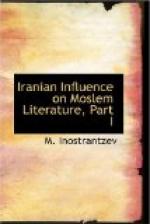As regards the political influence of the Persians on the tribes of Arabia a vast deal has been related in the pre-Moslem epoch. As is well-known, thanks mainly to the Persian influence, there was a small Arab kingdom of the Lekhmides in the South-Western portion of the Sasanian empire[1]. It played its part, most beneficial for Persia, holding back on the one hand Roman-Byzantine onrush from the West, and on the other restraining the perpetual attempts at irruption into Persian territory by Arab nomadic tribes. Not long before the appearance of Islam, Sasanian influence was extended to the Arabs and the South as well as Yemen passed into the sovereignty of the Persians. Khusro and his Court appeared to the Arab an unattainable ideal of grandeur and luxury.
[Footnote 1: Die Dynastie der Lekhmiden in al-Hira, Ein Versuch zur arabisch-persischen Geschichte zur Zeit der Sasaniden Berlin, 1899.]
The rapid conquest of Persia by the Arab warriors proved a complete catastrophe to the Sasanian empire. But Persian culture was not to be extirpated by the success of Arab arms. Persia was overwhelmed only externally and the Arabs were compelled to preserve a considerable deal of the past. Having lost the position of rulers, the Persian priesthood preserved intact its control of the indigenous populace in the eyes of the latter as well as of the foreign Government. The same remark holds good of the class of landed proprietors.[1] Iranian tradition continued to live In and with them. Not only what was preserved but all that was destroyed for long left vestiges in the memory of the conquerors.
[Footnote 1: Regarding the part played by this class in the times of the Khalifs, see A. Von Kramer Culturgeschiche des orients unter den Chalifen II. pp, 150, 62.]
Many years after the Arab conquest the ruins that covered Persia excited the admiration of the Arabs. Their geographers of the ninth and tenth centuries considered it their duty to enumerate the principal buildings of the Sasanians reminding the reader that here Khusro built in his time in bye-gone days a castle, there a mountain fastness, again at a third place, a bridge.[1] Regarding various ancient structures which had survived the Sasanian times, we refer, inter alia, to Istakhri, (ibid I), pp. 124; Ibn Hauqal (ibid II) 195; Ibn Khordadbeh (ibid VI) p. 43, (text); Ibn Rusteh (ibid VII), 153, 162, 164, 165, 166, 167, 189; Yakubi (ibid VII), 270, 271, 273, &c.
[Footnote 1: See the enumeration of the noteworthy buildings of ancient Persia as given in Makdisi (B.G.A. III), p. 399, and Ibn-ul-Fakih (ibid V), p. 267.]
The remains of the structures, monuments of art from the Sasanian times and the ages preceding them attracted the attention of the Arabs and they have left descriptions of the same in more or less detail.[1] From the information of the same Musalman writers we possess accurate accounts of the inhabitants of Persia and their religions. Thus, for instance, Yakubi indicates that the inhabitants of Isfahan, Merv, and Herat, consisted mainly of high-born Dehkans.[2] Makdisi notices a considerable number of fire-worshippers in several provinces of Persia, for instance, Irak and Jibal.[3]




